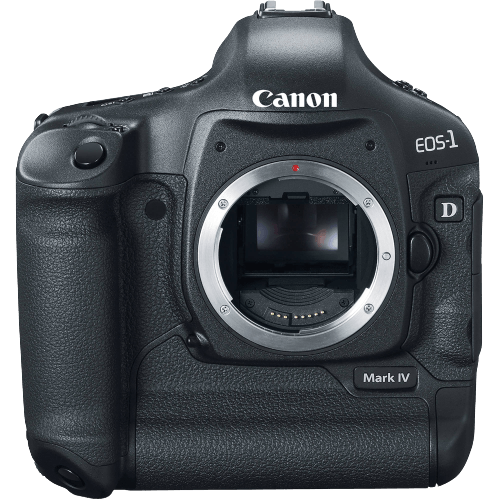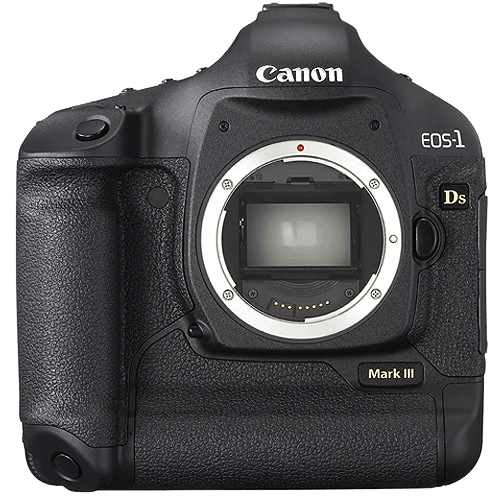Canon EOS 1D Mark IV vs EOS 1Ds Mark III Comparison
Canon EOS 1D Mark IV

Canon EOS 1Ds Mark III

The Canon EOS 1Ds Mark III emerges as the winner with a score of 58/100, while the Canon EOS 1D Mark IV trails behind with a score of 54/100. Both cameras share similarities, such as being DSLR types and having the same camera depth of 80mm.
The 1Ds Mark III excels with a higher score due to its larger size (150 x 160mm) and heavier weight (1385g). In contrast, the 1D Mark IV is smaller (156 x 157mm) and lighter (1230g), which could be an advantage for users who prioritize portability. Moreover, the 1D Mark IV is more affordable with a launch price of $5,840 compared to the 1Ds Mark III’s $7,100.
Taking these specifications into account, the Canon EOS 1Ds Mark III’s superior score reflects its better overall performance, while the Canon EOS 1D Mark IV offers a more compact and budget-friendly option.
Canon EOS 1D Mark IV vs EOS 1Ds Mark III Overview and Optics
The Canon EOS 1Ds Mark III triumphs over the Canon EOS 1D Mark IV in terms of optics with a score of 60/100 compared to the latter’s 54/100. Both cameras share some common specifications, such as having a CMOS sensor, Canon EF lens mount, and no image stabilization.
The 1Ds Mark III outshines the 1D Mark IV with its higher megapixel count of 21.1, which allows for greater image detail and larger prints. Additionally, it boasts a full-frame sensor size, which contributes to better image quality and low-light performance. Its DXOMARK sensor score of 80 further supports its superior image quality compared to the 1D Mark IV’s score of 74.
The 1D Mark IV, however, excels in shooting speed, capturing images at 10 frames per second, making it suitable for action photography. Its sensor size is APS-H, which is smaller than the 1Ds Mark III’s full-frame sensor, but it has a more advanced Digic 4 processor, which may result in faster processing and better color reproduction.
In terms of optics, the Canon EOS 1Ds Mark III is the clear winner due to its higher megapixel count, full-frame sensor, and better DXOMARK score. These features contribute to enhanced image quality and performance. On the other hand, the Canon EOS 1D Mark IV’s faster shooting speed and advanced processor make it a viable option for specific photography styles, such as action and sports. Ultimately, the choice between these two cameras depends on the specific needs and preferences of the photographer.
Canon EOS 1D Mark IV vs EOS 1Ds Mark III Video Performance
When comparing the video capabilities of the Canon EOS 1D Mark IV and the Canon EOS 1Ds Mark III, it is important to note that the Canon EOS 1Ds Mark III does not have video functionality. This means that the comparison in this aspect will focus solely on the Canon EOS 1D Mark IV.
The Canon EOS 1D Mark IV has a video score of 43 out of 100. This camera is capable of recording videos at a maximum resolution of Full HD, which translates to 1920 x 1080 pixels. The maximum video frame rate that this camera can achieve is 30 frames per second. Unfortunately, the Canon EOS 1D Mark IV does not have built-in time-lapse functionality.
Taking into account the video capabilities of both cameras, it is clear that the Canon EOS 1D Mark IV is the only option for those who require video functionality in their camera. The Canon EOS 1Ds Mark III, on the other hand, does not offer any video features. Therefore, the choice between these two cameras will depend on the user’s specific needs and priorities, such as whether video recording is essential or not.
Canon EOS 1D Mark IV vs EOS 1Ds Mark III Features and Benefits
The Canon EOS 1D Mark IV emerges as the winner with a feature score of 54/100, while the Canon EOS 1Ds Mark III trails behind with a score of 49/100. Both cameras share some common specifications, such as a 3-inch screen size, absence of a touchscreen, flip screen, GPS, and Bluetooth.
The Canon EOS 1D Mark IV outperforms the 1Ds Mark III mainly due to its superior screen resolution, which stands at 920,000 dots, as opposed to the 230,000 dots found in the 1Ds Mark III. This difference in screen resolution allows the 1D Mark IV to provide clearer and more detailed image previews and menu navigation, enhancing the overall user experience.
On the other hand, the Canon EOS 1Ds Mark III has an advantage over the 1D Mark IV in terms of connectivity, as it comes equipped with built-in Wi-Fi. This feature allows for easy and convenient sharing of images and remote control of the camera through a smartphone or tablet. However, this advantage does not outweigh the benefits provided by the 1D Mark IV’s higher screen resolution.
Taking these factors into account, it is evident that the Canon EOS 1D Mark IV is the superior camera in terms of features. Its higher screen resolution offers a better user experience, while the Wi-Fi connectivity of the 1Ds Mark III does not provide enough of an edge to surpass the 1D Mark IV.
Canon EOS 1D Mark IV vs EOS 1Ds Mark III Storage and Battery
The Canon EOS 1Ds Mark III outperforms the Canon EOS 1D Mark IV in storage and battery with a score of 84/100 compared to 48/100. Both cameras accept SD and Compact Flash (Type I or II) memory cards and share the same battery type, LP-E4. Neither camera has USB charging capabilities.
The 1Ds Mark III excels with two memory card slots and a longer battery life of 1800 shots, providing more flexibility and convenience for photographers. On the other hand, the 1D Mark IV has only one memory card slot and a shorter battery life of 1500 shots, which may be limiting in certain situations.
Despite the lower score in storage and battery, the 1D Mark IV still offers adequate performance for most users. However, the 1Ds Mark III’s superior storage and battery capabilities make it the better choice for those who require extended shooting capabilities and more storage options.
Canon EOS 1D Mark IV vs EOS 1Ds Mark III – Our Verdict
Are you still undecided about which camera is right for you? Have a look at these popular comparisons that feature the Canon EOS 1D Mark IV or the Canon EOS 1Ds Mark III:

